9 of the Best Hiking Backpacks Under $100 (2021)
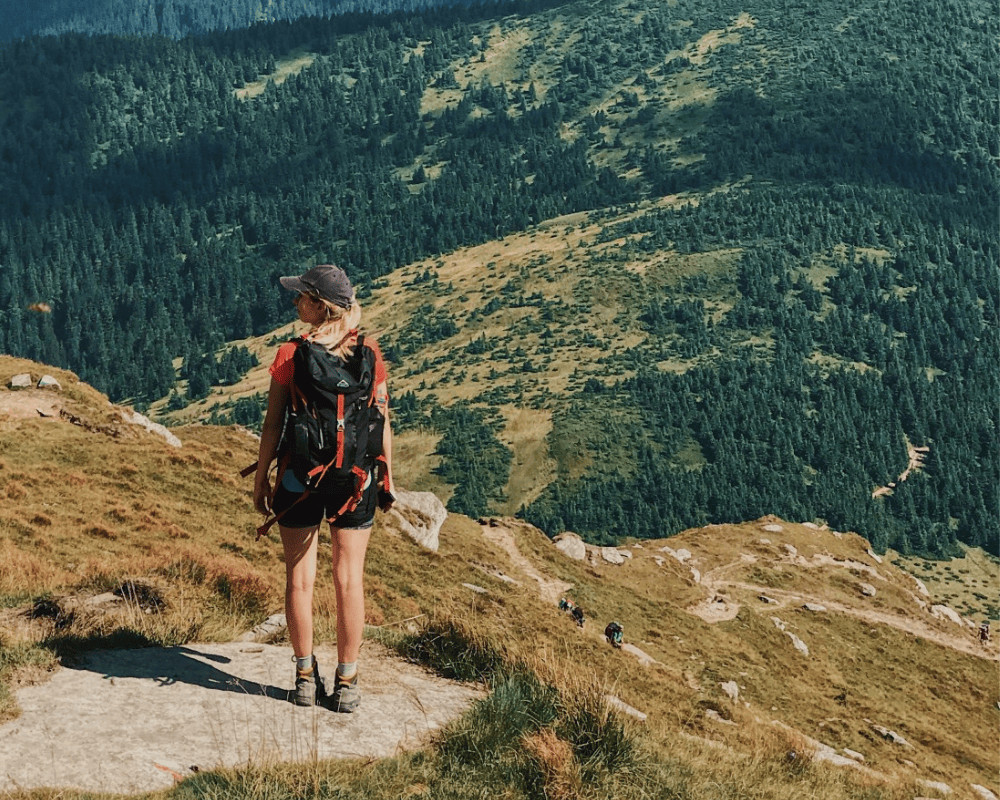
2020 was a year of surprises and 2021 is proving to be no different. What better way to escape the chaos of our world than trekking through the forest?! It’s an excellent way to calm your mind, reconnect with yourself, and enjoy some peace and quiet.
However, hiking without a good backpack can turn your peaceful expedition into a journey riddled with sore muscles and aching joints.
While you may think you have to spend hundreds (gasp—or more!) to find something nice, there are dozens of excellent budget-friendly hiking backpacks under $100. They’re perfect for beginners or anyone ballin’ on a tight budget itching to get outdoors.
In this article, I cover my top nine ballin’-on-a-budget recommendations, plus the pros & cons of each and a complete buyer’s guide to help you pick the right pack for your next adventure.
Our Top Three Picks:
The 9 Best Budget-Friendly Hiking Backpacks Under $100
Here’s a super-duper quick overview of our top choices. Scroll down for a more in-depth review of what we love & don’t love about each pack (plus when to use what and a complete buyer’s guide).
- Venture Pal 40L Lightweight – Our top pick under $100!
- Osprey Daylight Plus – Most comfortable small (20L) daypack
- Gregory Nano 18 – Best overall small (18L) hiking backpack
- The North Face Jester – Best for everyday use + day hiking
- Loowoko 50L – Best budget midsize backpack with a rain cover
- Teton Sports Scout 3400 – Best internal frame multi-day pack
- Mountaintop 70L/75L – Most capacity + space for your buck
- N NEVO Rhino – Best budget hiking backpack for women
- Deuter Junior – Best budget daypack for kids
#1 – The Best Overall Daypack Under $100
If you’re on the hunt for a budget-friendly and functional daypack without all the extra bells and whistles, the Venture Pal 40L is my top recommendation. It comes in 11 different colors (three of which are super awesome prints) with plenty of variation to match your preferred style.
There’s seriously an option for everyone and every single color variation is great.
However, the best part is how big it is—at a whopping 40L and only weighing 0.7 lbs, you’re getting a TON of space without the added weight of most midsize packs. There’s plenty of room for extra layers, a rain jacket, snacks, water, a first aid kit, camera gear, and anything else you may need during a day on the trail.
But keep in mind that it’s made from super lightweight material. You won’t be able to carry anything too heavy or bulky since it might be a bit too much for the seams and thin material to handle.
With that said, this pack is 100% machine washable so you can toss it in the machine whenever it needs a good cleaning and it packs down into a small cube for easy storage when you’re not using it. It’s also a great option if you travel a lot and need something that doesn’t take up too much space in your suitcase.
Snag yours at:
#2 – The Most Comfortable Small (20L) Daypack
If you’re anything like we are, comfort is a huge consideration even if you’re not carrying a lot of weight or hiking very far. Despite its (slightly) higher price tag and tiny capacity, the Osprey Daylite Plus is the most comfortable small daypack with one of the best ventilation systems we’ve seen.
On top of that, it includes both chest and waist straps to help evenly distribute your packs’ weight to your legs. Many daypacks don’t include a waist strap, so this is an excellent addition to an already superb lightweight hiking backpack.
There’s a padded internal compartment you can use as to hold a hydration bladder or a tablet/small laptop for everyday use. It also features an elastic shove-it pocket on the front where you can quickly store a light shell jacket or fleece layer as you start to warm up throughout the day.
But keep in mind that it is really small at only 20L (the second smallest pack on our list).
You won’t be able to carry a lot of gear, so we only recommend this pack if you hike pretty light with no bulky camera equipment or anything with sharp edges that might cut the fabric.
Pro-tip: If you already own a larger Osprey pack for longer tips, you can easily attach the Daylite Plus for added storage space and for use as a daypack on shorter adventures or hikes away from camp.
Snag Yours At:
#3 – Best Overall Small (18L) Day Hiking Backpack
If you’re on a tighter budget and don’t mind sacrificing a bit in terms of comfort and weight, the Gregory Nano 18L is our top pick for the best overall small-sized daypack. Coming in at just 18L, it’s the smallest pack on our list but it’s perfect for short hikes that don’t require a lot of gear.
Its sleek and narrow low-profile design makes it perfect for scrambling, bushwhacking, or navigating through overgrown trails with a lot of snag potential (I totally just made that up—but you know what I mean).
As far as features go, it’s not lacking anything essential despite its budget-friendly price tag.
It comes with two easy-release compression straps to further reduce the pack’s profile when it’s fully loaded, chest + waist straps to give your shoulders a break, a dual-purpose padded pocket for a small tablet or hydration bladder, and a quick-access zippered top pocket for small items like keys or your wallet.
One thing to note: it’s long & slender profile and isn’t suitable for anyone with a torso that’s 16″ or shorter.
Snag Yours At:
#4 – Best for Everyday Use + Day Hikes
The North Face Jester backpack is a bit different from the other options on our list because it’s designed as a standard backpack and not specifically for hiking. So, it’s a smart choice if you’re looking for something you can use as an everyday backpack AND as a daypack for easy days on the trail.
Despite being decent-sized at 28L, it’s lightweight (even lighter than the 18L Gregory Nano). Which… makes sense knowing the pack’s commonly used by college students lugging around massive textbooks all day.
Since it’s built for college students, there’s no shortage of pockets and compartments to stay organized.
With that said, the smaller organization pockets are along the backside (closest to your back), making the weight distribution feel very off if you have a lot of heavy items in those small pockets.
Despite that weird quirk and the lack of a waist strap to help counterbalance it, the pack features a FlexVent suspension system with custom shoulder straps and a padded + well-ventilated back lumbar panel for all-day comfort and breathability.
So, it’s suitable for even the warmest hikes where sweating is more likely than not.
Snag Yours At:
#5 – Best Frameless Multi-Day Hiking Backpack
For overnight or short multi-day hikes, you need something with more room to pack your tent, summer or winter hiking pants, jackets, sleeping pad, sleeping bag, food, water, and other essentials. A small 20L pack won’t cut it and even a 35 or 40L pack is pushing it. You also need something that’s going to hold up if the weather suddenly changes (as it does in the PNW—hello afternoon showers!).
Enter… the Loowoko 50L. Its spacious and well-padded design gives you plenty of room to store everything you need (assuming you pack smart) and the polyester rain cover fits snugly while keeping the wet… out.
Going on your first backpacking trip? Check out our top tips for beginner backpackers!
It’s an excellent choice if you prefer the lightweight flexibility of frameless hiking backpacks.
Most hiking backpacks (especially those of the budget-friendly variety) don’t come with a rain cover. In those cases, you have to buy one separately and hope that it fits well enough to do the job. However, the Loowoko rain cover fits like a glove so you don’t have to worry about scouring for the right fit or spending even more money.
On top of that, there are eight adjustable external straps perfect for hanging a sleeping bag, tent, hiking poles, extra shoes, water shoes, water bottles, or even a comfy camp chair.
There’s also a handy easy-access waist strap pocket for small items like your phone or a protein bar.
One thing to note is that packing this puppy can get difficult and rather frustrating since it doesn’t have an internal frame. Its tall dimension makes it fold in on itself until it’s full enough to support its own weight.
I wouldn’t consider that a deal breaker though, especially at such a low price.
Snag Yours At:
#6 – Best Internal Frame Multi-Day Hiking Backpack
Frameless backpacks—like the Loowoko 50L—are excellent if you’re carrying less than 25(ish) lbs. However, that’s probably the most we’d ever carry without a frame. While most internal frame packs are outside of our $100 limit, there’s one that sneaks in right at the top.
The Teton Sports Scout 3400 (that’s a mouthful) is a budget-friendly internal frame hiking backpack with a generous 55L capacity, coming in just above four lbs.
It’s heavier than the other packs on our list and it’s also a bit bulkier with a larger profile. But that’s because of its sturdy aluminum frame. Aside from adding additional support, the frame helps keep the pack upright when you’re packing (which may not sound like a big deal but is a HUGE benefit).
On top of that, the pack is completely adjustable for hikers with different torsos. It’s fully adjustable from 15″ to 19″ to fit most young adults, women, and men.
You can also adjust the chest, waist, and shoulder straps to fit snugly against your body.
In terms of features, you’ll enjoy a separate sleeping bag compartment (14″x8″x8″), a channeled back panel to wick moisture away from your back, various compression straps, a hydration bladder pocket (bladder not included) that fits up to 3L, and numerous external straps for hanging gear.
Snag Yours At:
#7 – Most Capacity + Space for Your Buck
If 50L isn’t enough space, you’re not completely out of luck finding something under the $100 cap. Believe it or not, the Mountaintop 70/75L internal frame backpack is actually cheaper than the smaller 50L Teton Sports Scout 3400. It’s also HUGE at 70 (or 75) liters. Plus, this one includes waist strap pockets for all the snackage.
It also features a completely adjustable torso height with eight different options. On top of that, the waist strap can go as small as 29.9″ and as large as 57″ to fit hikers of all sizes.
With that said, it may not be tight enough for petite hikers, so keep that in mind before making your purchase.
One of this pack’s standout features is an easy access zipper at the bottom (there’s also one on the side!) of the main compartment. These extra access options make it easy to snag things at the bottom of your pack without having to unpack the entire thing or dig around blind.
You also get numerous compression straps, a hydration compartment that fits bladders up to 3L, a drawstring enclosure at the top that allows for more space if you need it, and a rain cover.
Snag Yours At:
#8 – Best Budget Hiking Backpack for Women
Despite being marked as a pack for men and women, the N NEVO Rhino is built for hikers with a smaller frame.
Its internal frame design and openwork mesh material also create a very breathable and well-ventilated experience since it helps keep the pack’s fabric away from your back.
However, the best part about this pack is that it comes in SO MANY sizes, making it an excellent choice for various types of hiking. Interested in day hiking on a budget? Go with a smaller 40L. Want to explore a bit further and push yourself for a few days? Opt for the 65 or 80L.
With most sizes, you can also add an additional 5L thanks to an extension collar at the top.
Since it’s designed for smaller hikers, the waist strap buckle is designed to help distribute your pack’s weight down into your legs and trunk to make things easier on your shoulders + upper back.
You’ll also enjoy various compression straps, numerous external loops and straps for hanging gear, compatibility with most hydration bladders, a small pocket at the top with a loop to attach your keys, and a durable rain cover for those afternoon showers.
There’s also an elastic shove-it pocket on the front for easy storage of your extra layers.
Snag Yours At:
#9 – The Best Budget Daypack for Kids
Looking for a small daypack for the youngin’s? The Deuter Junior pack is an excellent introductory option for kids roughly aged 5 – 12 (although it depends on their size more than anything).
The pack is incredibly lightweight, simple, and well ventilated to keep kids cool in the summer. It features foam air channels and breathable mesh that facilitate more airflow between their back and the pack itself. On top of that, it comes in numerous kid-approved colors so they can flaunt their styles too.
It’s also the perfect size to get your children used to carrying weight on their backs while on the trail.
However, the best part is that this pack is built specifically for kids. You don’t have to worry about sizing down to the smallest size just to get a decent fit. And there’s plenty of room for them to grow over the next few years.
You’ll also enjoy an identification tag on the inside to help prevent mix-ups at school or while out on the trail and a 3M reflector for enhanced visibility at all times.
Snag Yours At:
Best Budget-Friendly Hiking Backpack Comparison Table
Venture Pal 40L
| Osprey Daylite Plus
| Gregory Nano 18L
| The North Face Jester
| Loowoko 50L
| Teton Sports Scout
| Mountaintop 70/75L
| N NEVO Rhino
| Deuter Junior
|
Honorable Mentions: Best Hiking Backpacks Under $150
Looking for something else, or willing to spend just a smidge more to snag a budget hiking backpack with a little less weight and a few more bells and whistles? Here are our top recommendations for packs under $150:
- M.U.L.E. Hydration Pack – Best hydration pack
- Osprey Tempest 30L – Best women’s midsize daypack
- Osprey Talon 33L – Best men’s midsize daypack
- TETON Sports Lightweight – Best internal frame 90L backpack
- Gregory Icarus 40L – Best midsize hiking backpack for kids
How to Choose the Best Budget Hiking Backpack for You
When choosing a backpack, there are several factors to think about as you go through the process. And… if you’re anything like me, you overanalyze every single detail even though you don’t really need to.
So, I put together a definitive list of considerations to walk through that’ll help you make the right decision the first time. Minus all the headaches, millions of tabs open at the same time, and diving too much into features that don’t matter.
1. Decide Which “Type” Is Right for You
The best type of budget backpack depends on how far you plan to hike. For day trips, you don’t need anything too big. But for longer treks, you’ll need more space and capacity to hold overnight gear like a tent, sleeping bag, clothes, food, and more.
So, the first thing you need to do is decide which type or pack is right for your next adventure.
Small daypack – suitable for short hikes that require very little gear. They’re typically less than 20L and lightweight with minimal features. You can usually fit one layer, some snacks, and water inside.
Daypack – suitable for day hikes that demand a bit more gear. For example, hiking in the snow requires snowshoes or microspikes plus extra layers. Another example is hiking for 8+ hours in one day. This requires a lot more water than a shorter hike. As such, you’ll need adequate space to store extra gear, layers, food, and water when you’re not using them. These typically range from 25L to 40L.
Frameless multi-day pack – this type of pack has more space for overnight gear like sleeping bags, tents, hiking poles, tarps, and extra food/water. They’re typically larger than 40L but only suitable for lightweight adventures (we recommend carrying less than 25-ish lbs). This type is good for narrow trails and scrambling since its profile is much narrower than its framed counterpart.
Internal frame – if you plan to carry more than 25-ish lbs, an internal frame pack is your best bet. These can range in size from 40L all the way up to 90L or more. The frame helps it hold its shape and facilitates airflow between the pack and your back. As a result, it’s more comfortable with heavy loads. However, they are bulkier and larger in profile than frameless packs.
Once you know what type and capacity you need, you should focus next on finding a good fit.
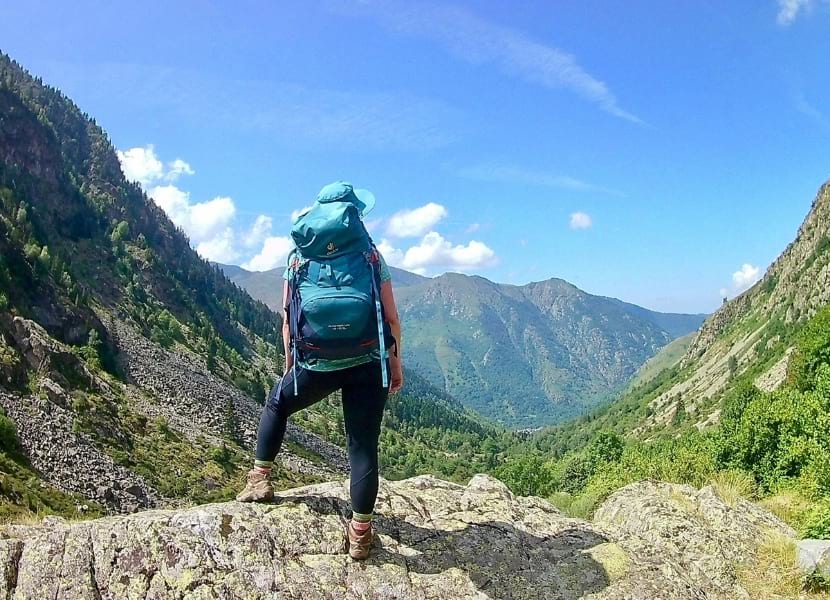
2. Check the Dimensions for a Good Fit
When buying a hiking backpack online, you can’t exactly… try it on. In some places, you can’t even try them on in-store either (thanks COVID). So, the next best thing is to measure yourself to find the perfect fit.
The most important measurement is the length of your torso. But you also need to measure your waist as well to ensure the pack you choose accommodates your size.
How to measure your torso: stand up and tilt your head forward as far as you can – you’ll feel a “knot” at the base of your neck and this is your starting point. Then, put your hands on your hips and measure straight down your spine from the starting point to the point where your spine intersects the invisible line made with your hands on your hips. Pro-tip: you’ll need a friend to help you out!
Now you can use your torso length to ensure you choose a pack that fits well. Many larger packs are adjustable to fit hikers of all sizes, which is great. But just be sure that range includes your torso length before buying.
How to measure your waist: put your hands on your hips and measure around your entire torso along the line your index fingers and thumbs create.
Waist size is typically more of an issue for very petite hikers and kids. However, most hiking backpacks give you a range of waist/hip sizes.
We highly recommend loading your pack and trying it on at home before taking it out on the trail. Doing so allows you to make adjustments to the chest, waist, and shoulder straps. You can also adjust the torso length for a snug fit. Note: if you can’t get comfortable at home, you may want to return it and try something else.
You’ll also probably do a bit of adjusting on the trail as you start to move around.
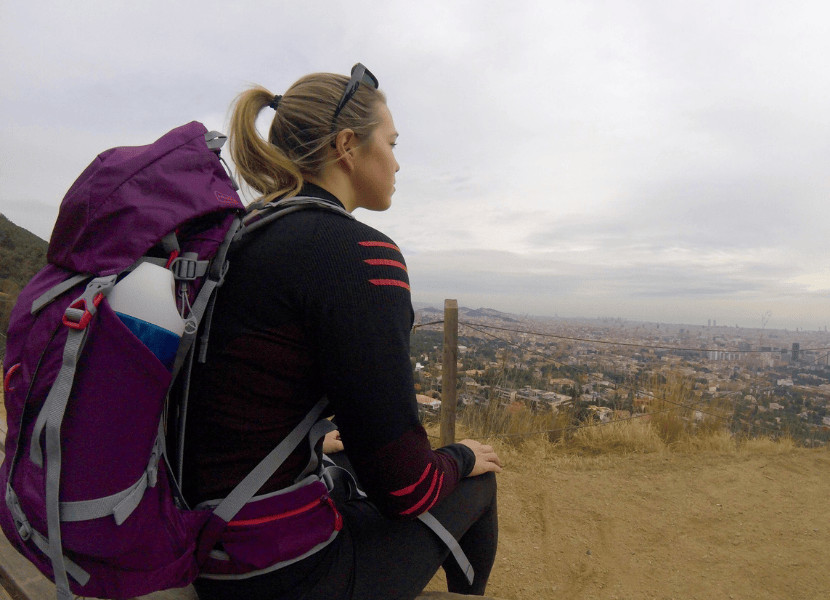
3. Pay Attention to Pack Ventilation
Ventilation and breathability are important to consider, especially if you’re hiking in warm weather. Some packs are better than others because they use lightweight mesh materials for the shoulder straps and back panel. Lighter, mesh materials let more air in, resulting in a more comfortable experience with plenty of breathability.
Packs with frames also tend to be more breathable since the frame helps the pack maintain its shape, resulting in more empty space between the pack and your back.
When making your final decision, opt for a hiking backpack with a ventilation system and breathable materials.
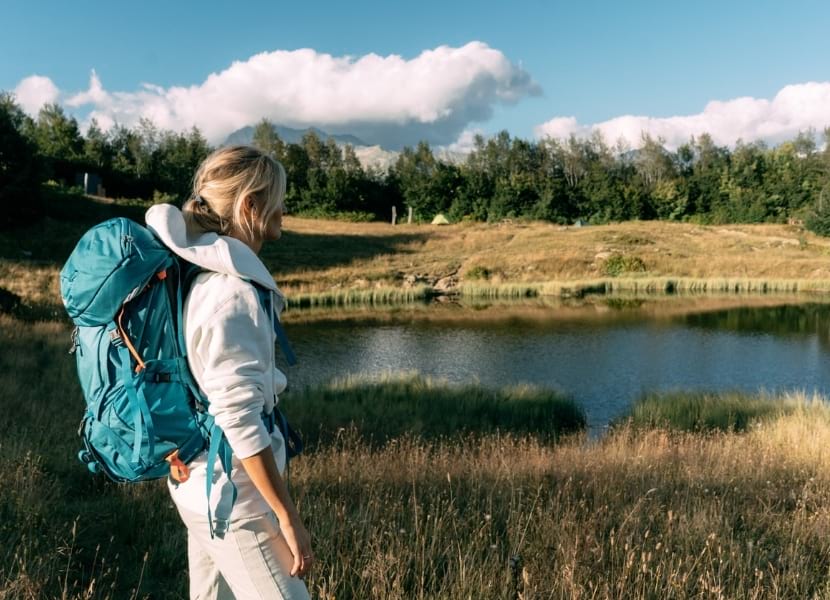
4. Optional Considerations
There are several other things you may want to look for, depending on the weather, how much weight you’re carrying, and how far you’re going. Some of those considerations include:
- Weight – the weight of the backpack itself becomes more of an issue when you’re hiking long distances over several days. With that said, weight isn’t something you have a lot of choice in if you’re looking for something under $100 (especially at higher capacities).
- A rain cover – most hiking backpacks aren’t waterproof and require a rain cover in the snow or rain. Some packs come with them while others don’t, requiring you to buy one separately.
- Hydration compartment – for shorter hikes, you can get by using a water bottle. However, a hydration bladder becomes crucial for longer hikes. Because of that, many day packs don’t include a compartment to store one. You have to decide if that’s a feature you need or don’t need. With that said, most higher-capacity packs have a dedicated hydration bladder compartment.
- Material – we prefer Nylon material over Polyester, but it’s completely up to you. Nylon is a bit softer, more stretchy, stronger (usually), and shinier. It can also absorb water (making it heavier as it gets wet) and typically comes paired with a water-proof coating. On the other hand, Polyester is less prone to tears and holds color far better than Nylon. It’s also naturally water-resistant.
Still haven’t decided? No problem!
Click here to pop back up to our comparison table for the best hiking backpacks under $100.
Frequently Asked Questions
Our top budget-friendly pick is the Venture Pal 40L. It’s insanely lightweight, folds down for easy storage, is machine washable, and clocks in at just $22 on Amazon.
The easy answer? As light as possible! However, weight of the pack itself isn’t something you get a lot of say in if you’re ballin’ on a tight budget—this is especially true when you start looking into backpacks for multi-day trips.
Hiking backpacks can range drastically in price, from less than $20 to upwards of $600 or more. However, you can get a decent pack for under $100 if you’re new to hiking or on a tight budget.
We highly recommend the N NEVO Rhino for women. It’s built for hikers with a smaller frame and comes in a wide range of sizes (40 / 50 / 60 / 65 / 80L), all of which cost less than $100.
Many of them can. However, limits vary depending on the airline and we highly recommend checking with the individual airline you’re traveling with to make sure your backpack will fit.
Was this article fantastic? The worst? So-so? If you can answer “uhhhh yes” to any of those questions, take a moment and share it with your friends!
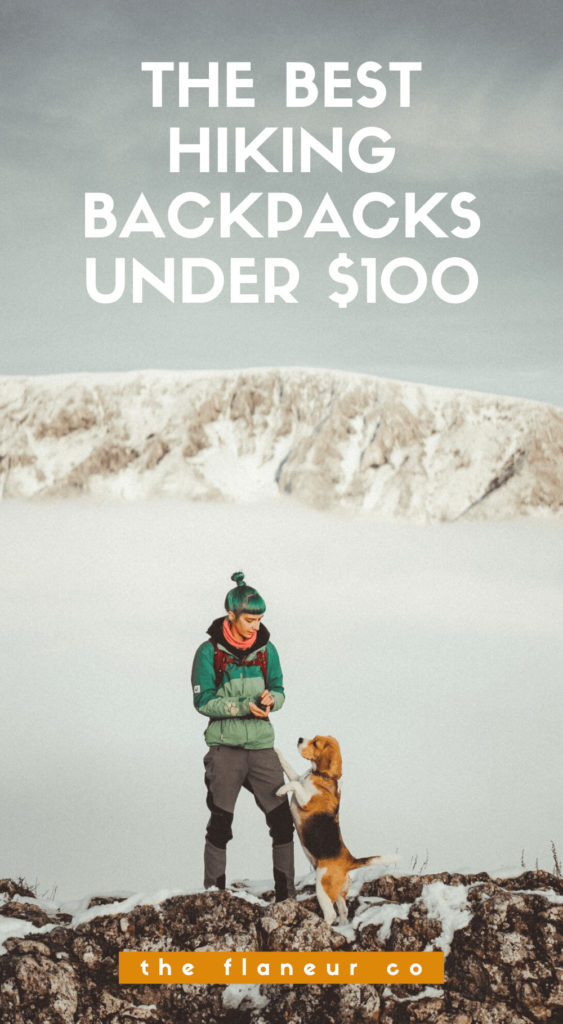
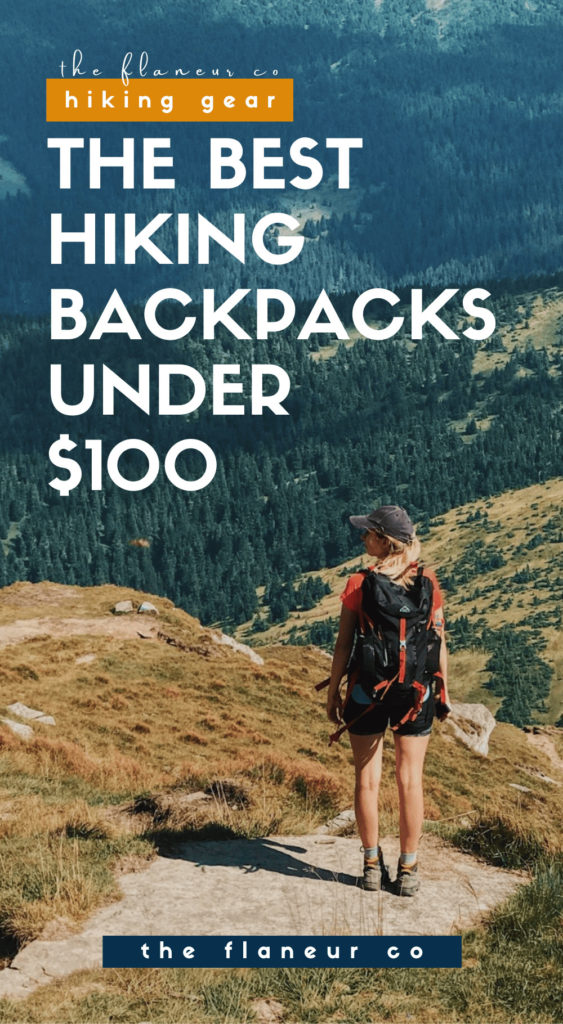
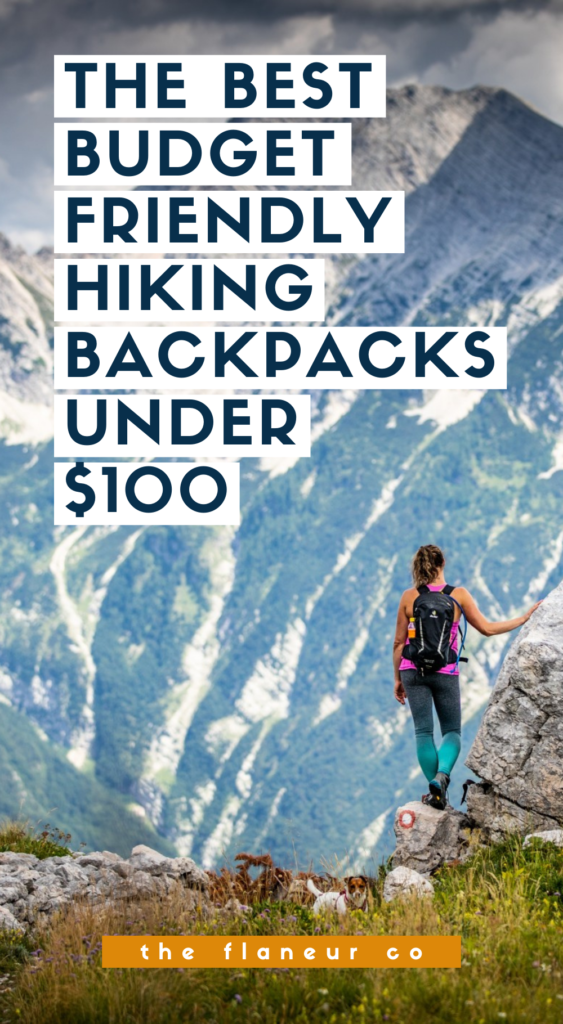
We’ll talk soon! Until then,
Cait








